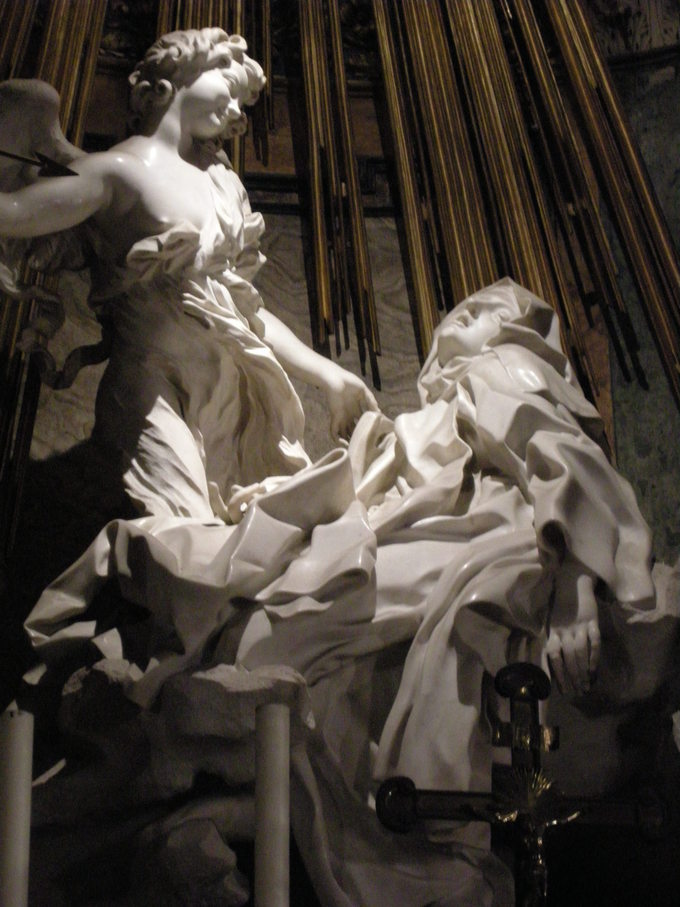21.3: Sculpture of the Baroque Period
- Page ID
- 53071
Italian Sculpture in the Baroque Period
Baroque sculpture dominated Italy in the 1600s and was characterized by sculpture in the round.
Learning Objectives
Indicate the attributes of Baroque sculpture in 17th century Italy
Key Takeaways
Key Points
- Baroque sculpture attempted to capture dynamic movement of human figures, spiraling around an empty central vortex or reaching outwards into the surrounding space .
- Baroque sculpture was meant to be viewed from all angles and displayed centrally, rather than against a wall.
- Gian Lorenzo Bernini was the most important Italian sculptor during the Baroque Period, both in Rome and throughout Europe.
- Bernini’s sculpture of French ruler Louis XIV set the standard for royal portraiture for a century.
Key Terms
- relief: A type of artwork in which shapes or figures protrude from a flat background.
- relief sculpture: A type of sculpture that gives the impression that the sculpted material has been raised above the background plane.
Overview: Baroque Sculpture
Baroque sculpture is associated with the Baroque cultural movement in 17th century Europe. In Baroque sculpture, groups of figures assumed new importance, and there was a dynamic movement and energy of human forms—they spiraled around an empty central vortex or reached outwards into the surrounding space. Baroque sculpture often had multiple ideal viewing angles and reflected a general continuation of the Renaissance’s move away from relief to sculpture created in the round . They were typically designed to be placed in the middle of a large space; for example, elaborate fountains such as Bernini’s Fontana dei Quattro Fiumi (Rome, 1651) or those in the Gardens of Versailles were a Baroque specialty.
A great deal of Baroque sculpture added extra-sculptural elements; for example, concealed lighting, water fountains, or fused sculpture and architecture that created a transformative experience for the viewer . Artists saw themselves as working in the classical tradition and admired Hellenistic and later Roman sculpture.
The Work of Bernini
Gian Lorenzo Bernini was the dominating figure of the age. Bernini’s sculptural output was immense and varied. The Ecstasy of St. Theresa in the Cornaro Chapel, Santa Maria della Vittoria, and the now-hidden Constantine at the base of the Scala Regia (which he designed) were among his best known works. Bernini was also given the commission for the Tomb of Pope Urban VIII in St Peters.

Ecstasy of St. Theresa by Bernini: Bernini was the most prominent sculptor of the Baroque period.
In 1665, at the height of his fame, Bernini traveled to Paris for several months in response to repeated requests for his works by King Louis XIV. His international popularity was such that the streets were lined with admiring crowds during his walks in the city. Here, Bernini presented some designs for the east front of the Louvre, which were ultimately rejected. He soon lost favor at the French court as he praised the art and architecture of Italy over that of France. The sole work remaining from his time in Paris is a bust of Louis XIV, which set the standard for royal portraiture for a century.
- Curation and Revision. Provided by: Boundless.com. License: CC BY-SA: Attribution-ShareAlike
- Gian Lorenzo Bernini. Provided by: Wikipedia. Located at: en.Wikipedia.org/wiki/Gian_Lorenzo_Bernini%23Rise_to_master_sculptor. License: Public Domain: No Known Copyright
- Baroque sculpture. Provided by: Wikipedia. Located at: en.Wikipedia.org/wiki/Baroque_sculpture. License: CC BY-SA: Attribution-ShareAlike
- Gian Lorenzo Bernini. Provided by: Wikipedia. Located at: en.Wikipedia.org/wiki/Gian_Lorenzo_Bernini%23Rise_to_master_sculptor. License: CC BY-SA: Attribution-ShareAlike
- relief. Provided by: Wiktionary. Located at: en.wiktionary.org/wiki/relief. License: CC BY-SA: Attribution-ShareAlike
- Boundless. Provided by: Boundless Learning. Located at: www.boundless.com//art-history/definition/relief-sculpture. License: CC BY-SA: Attribution-ShareAlike

